SPECIAL REPORT: One year after flood damaged PHCs in Jigawa, govt neglects repairs
The aftermath of devastating floods in Jigawa State continues to haunt residents as critical healthcare facilities remain dilapidated over a year later. In this report, Sylvia Okedi reports that rural healthcare facilities in the state bear the brunt of this neglect, leaving communities in the lurch.
By Sylvia Okedi
Laiti Abdulrahaman, a young mother of two, stood amidst the chaos, her face etched with astonishment, as healthcare workers fought to salvage what little remained of the waterlogged clinic at the Zangon Kanya Primary Healthcare Centre (PHC) in the Ringim local government area (LGA) of Jigawa State. Her restless daughter, bundled tightly on her back, needed vital immunization injections.
Unsettled and anxious, she found herself waiting in a surreal scene, with other women, all carrying the same hopes for their children, lining up amidst the floodwaters. As the water continued to rise, reaching knee-deep levels, Laiti struggled to stay afloat both physically and emotionally.
In a voice trembling with concern, she shared with SOLACEBASE, “Before now, heavy rainfall of this magnitude was a rare occurrence for us.”

She continued, “But for the past five years, with last year’s flood being the most devastating, it has become an ever-present challenge. When the facility became submerged, I had no choice but to sit inside that waterlogged clinic, all in the name of ensuring my child received the crucial immunization she needed.”
Continuing the harrowing narrative, Aisha Muhammad, aged 25, found herself facing an equally dire situation at the Walawa Primary Healthcare Centre, situated just a stone’s throw away from Laiti’s beleaguered Zangon Kanya PHC within the same Local Government Area.
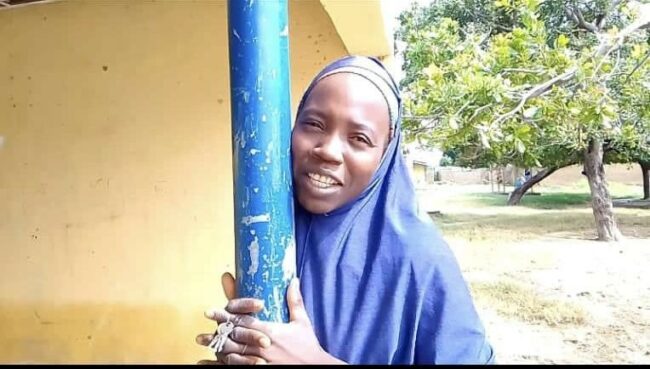
Photo caption: Laiti Abdulrahaman
Aisha Mohammed, a mother of five, arrived at the Walawa PHC only to be confronted by a distressing sight – the facility submerged by water. The torrential rains from the previous night had dealt a devastating blow, rendering the health center incapacitated. In a desperate bid for help, Aisha reluctantly paid N300 for a grueling 5-kilometer journey to the Ringim General Hospital.
Exhausted and disheartened, she finally reached the General Hospital, only to be met with an overwhelming sight. She met a long queue of patients well over a hundred people in line, all yearning for medical attention. Aisha had no choice but to join the forlorn queue, knowing that her feverish son was in dire need of care.
Narrating her ordeal, she said, “This clinic is closer to us, which is why I came here, but I found myself waiting for several hours with the hope that my son would receive treatment for malaria. The healthcare workers were toiling tirelessly to salvage equipment, files, and other essentials that had been submerged by the floodwaters from last night’s relentless rain.”
“I had already spent so much time waiting at the Walawa clinic, and when I finally reached the general hospital around 10 am, it was already too late. The clock ticked past noon, and I was still waiting to be attended to.”
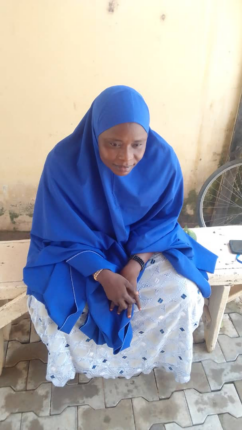
Photo caption: Aisha Muhammed
In their stories, Laiti and Aisha embody the shared struggle of many within Jigawa State, where access to healthcare, though close, often remains agonizing out of reach due to a host of issues, particularly the relentless forces of nature.
Floodings in Jigawa State and its impact on PHCs
Every year, when the Lagdo Dam basin in Cameroon discharges its waters, various states in Nigeria face a massive amount of flooding. Jigawa state in northwest Nigeria, however, had one of the worst effects of floods in 2022, with infrastructure, particularly Primary Healthcare Centres (PHCs), being devastated. This flood crisis was widely regarded as the nation’s worst natural disaster in a decade.
For Jigawa state, flooding has become a recurring and formidable environmental disaster, especially during the rainy season. The region grapples with immense challenges as it faces widespread damage to both lives and properties. This plight is primarily attributed to inadequate infrastructure for drainage and dredging systems, compounded by the notorious River Hadejia, which consistently breaches its banks, resulting in widespread flooding of the state.
A United Nations Children’s Fund UNICEF report said a total of 30 health facilities were submerged in 2022 by the flood and were declared out of use, while more than 200 were badly damaged.
Similarly, statistics of the Jigawa Flood Control and Mitigation Committee also showed that the 2022 flood affected 22 LGAs, and submerged 1,554 villages, and 130 persons lost their lives across Ringim, Dutse, Jahun, Miga, Auyo, Kafin Hausa, Guri, and Hadejia LGAs.
While the floodwaters have subsided in several villages throughout the State, residents remain deeply dissatisfied with the profound impact the flood has had on their lives.
SOLACEBASE findings showed that the majority of the affected PHCs in both rural and urban areas continue to grapple with significant physical deterioration resulting from the flooding. These facilities not only suffer from severe understaffing but also exhibit dilapidated building structures. Moreover, a common issue in many of these facilities is water leakage from the roof, especially at the corners of the walls.
Long-distance ride to access healthcare
Findings by this newspaper also revealed that in numerous rural communities such as Zango Kanya, and Dangawa are now compelled to undertake arduous journeys to neighboring communities in search of medical care.
Binta Musa, a resident of Dangawa community, spent close to three hours waiting in line at the Kudai Primary Healthcare Center in Dutse LGA, the capital city in Jigawa. Aged 25 and in her second trimester, she was there for her antenatal check-up. Reflecting on the previous year, she recounted the challenges of having to travel from her community to the Kudai healthcare facility in Dutse for adequate medical attention.
Like many individuals who recognize the importance of seeking healthcare at a medical facility rather than resorting to self-medication, Binta explained that she felt obliged to wade through the floodwater and take a longer route to access medical care for her son, who was suffering from malaria.
“We became soaked on our journey from the village to the clinic because our village was also affected by the flooding,” she said.
“In order to avoid the floodwater in Dangawa, I opted for a longer route using a motorcycle to reach the healthcare facility. Nevertheless, we still had to traverse the floodwater to enter the clinic.”
The 12-year-old Kudai PHC, which has over 15 health workers and serves over 17,000 people monthly, from various villages during the flood. However, the floodwater has hindered patients and health workers from accessing the facility.
Dilapidated infrastructure and flooding harming access to medical services in Jigawa
Lack of infrastructure and poor flood management in Jigawa state are two major causes that have damaged healthcare facilities and made it difficult for people to access healthcare. In July, 2023 the state government announced the acquisition of two dredging machines and the commencement of the River Hadejia dredging project, aimed at clearing waterways and preventing future flooding incidents, particularly in response to the devastating floods witnessed the previous year.
Kudai PHC’s Medical Laboratory Head, Lubabatu Hamza, revealed to SOLACEBASE that the floods of 2022 isolated the health facility for three days, rendering them unable to provide emergency or general medical services.
She also emphasized the PHC’s commitment to reaching remote areas, like Dan Masara, within its jurisdiction to offer medical assistance. However, she expressed frustration with government officials who, despite visiting the area, took no decisive actions to address the persistent flooding issue.
“While government officials frequently visit the community, oversee the situation, and make promises, no concrete actions have been taken to address the recurring flood problem,” she said.
According to the Jigawa State government website, in 2023, the state government approved a budget of N1.720bn for its Primary Health Care Development Agency (PHCDA). In the previous years, similar allocations were made, with an estimated N2.171bn approved for PHCs in 2022, and N2bn for PHCs in 2021 in the state.
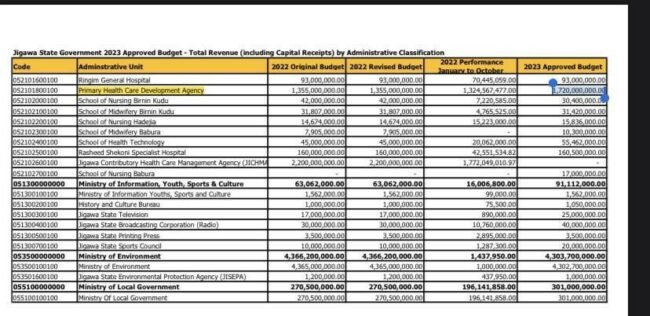
Ravaged by Floods: Karnaya PHC Struggles Amidst Community Displacement
At the Karnaya PHC, the facility lacks basic amenities such as beds in the admission wards, vaccine coolers, and enough benches for patients. There were just two workers on site, a volunteer, and a cleaner. And many of the patients were seated on the floor.
The community located in Dutse LGA, had faced complete submersion due to flood waters this year. This disaster, according to residents and village heads, displaced more than 4,000 residents and caused extensive damage to numerous houses. As a result, the affected residents were compelled to seek refuge in the nearest community school.
Sailuna, a resident who preferred not to disclose her full name, shared with this reporter that the flood in the previous year had wreaked havoc on the entire village. The houses, primarily constructed from mud with reed roofs, were overwhelmed, compelling the entire community to take refuge in a nearby school and even filling stations.
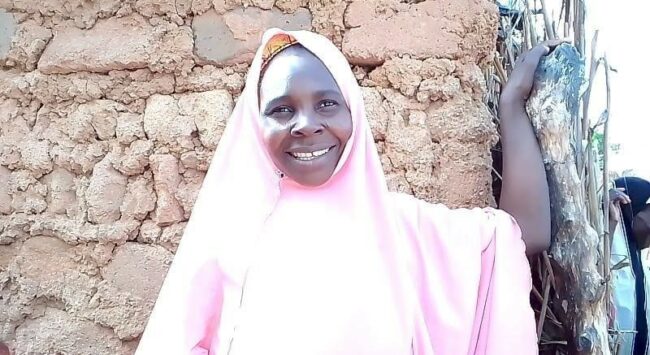
Photo Caption: Sailuna
Tragically, some individuals lost their lives in the process of seeking shelter, with children and pregnant women falling ill from malaria fever due to exposure to mosquito bites. Sailuna emphasized that accessing the primary healthcare facility in the village was impossible due to it being submerged by the flood.
“The health workers did their best. They assisted women in giving birth right there and provided medicine for our sick children,” she said, emphasizing the extent of the devastation that forced health workers to bring healthcare services to them under a tree in the school where they sought shelter.
“When we returned after the floodwaters receded, we discovered our homes were in ruins due to the deluge, leaving us homeless,” she added.
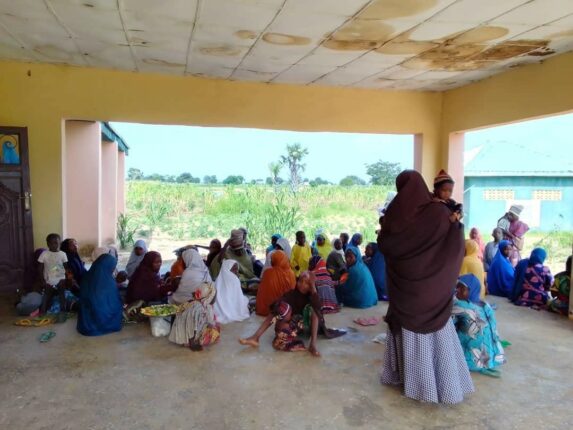
Photo Caption: Patients at Karnaya Primary Healthcare Center (PHC) sitting on the floor
“With the floodwaters reaching waist-deep, we ventured inside to retrieve medical equipment, carrying them on our heads to the schools where people had sought refuge to provide medical assistance,” disclosed Sabuwa Ahmadu, a volunteer at the Karnaya PHC.
According to Sabuwa, the flood affected the health facility causing cracks in the walls, and loss of drugs and other equipment, adding that they had no access to the PHC for about 3 months.
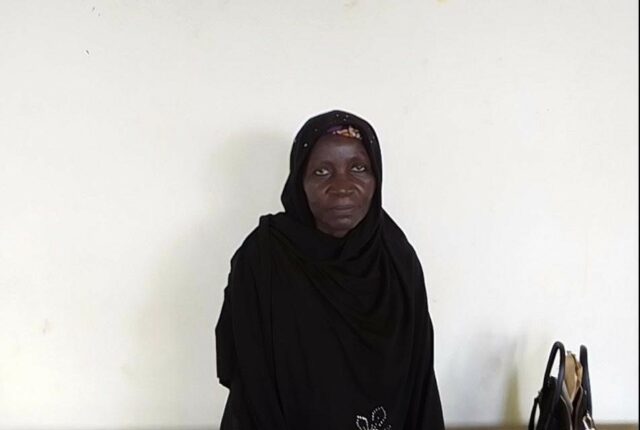
Photo Caption: Sabuwa Ahmadu
According to Adamu Ahmed, the head of Karnaya Village, the clinics in the neighborhood became submerged during last year’s flooding. In light of this, he said that the new administration had made an attempt to divert the water, and that without their action, the people would have been uprooted and left without access to appropriate healthcare.
“The reason it (the PHC) wasn’t completely destroyed is because it’s situated on slightly elevated ground. Nonetheless, for three months, during the period when the floodwaters hadn’t receded, women and anyone else couldn’t access the hospital; they had to wade through the floodwaters.” Adamu said
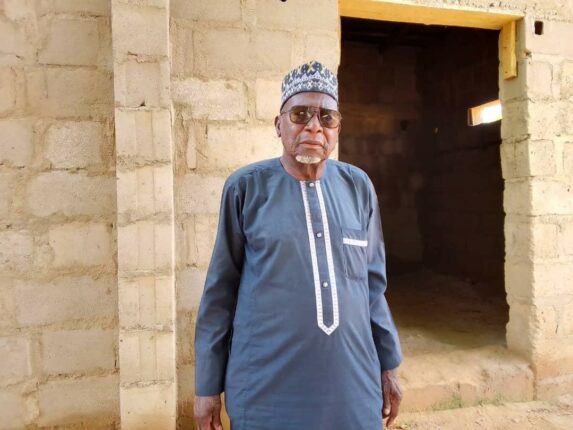
Photo Caption: Adamu Ahmed, the Head of Karnaya Village
Healthcare professionals express concern over insufficient government intervention
Nura Baffa, who assumed the position of Officer-In-Charge (OIC) at Karnaya PHC nearly a year ago, disclosed to SOLACEBASE details about the PHC’s submersion during the flood and the subsequent damage to numerous clinical equipment.
He went on to explain that Karnaya PHC operates with only three clinical staff members, comprising a nurse (who also acts as a midwife), the head record officer, a permanent cleaner, and two volunteers, including himself.
He emphasised that the clinic is inadequately staffed, with limited financial resources, and can only provide minimal assistance during childbirth, primarily in cases where the baby is already partially delivered.
Baffa pointed out that the facility is currently in the process of revitalization, as it has been selected to benefit from the Basic Healthcare Provision Fund (BHCPF) initiated by the Federal Government in collaboration with the National Primary Health Care Development Agency (NPHCDA).
Read Also:FEC approves creation of $5bn humanitarian, poverty alleviation trust fund – Minister
“They said the federal government, under NPHCDA, would be sending some funds to the facility quarterly, which is about N300,000. We were asked to create a monthly budget for the PHC to determine how we can revitalise it. Hopefully, the PHC will soon be capable of handling deliveries,” he said, adding that the current state governor seems to be serious with inspecting and following up on health facilities in the state.
Walawa Primary Healthcare Center (PHC) serves around 20,000 residents from 20 settlements and nearby villages, but it grapples with significant challenges. The facility, constructed over four decades ago in a low-lying area, frequently suffers from flooding. Despite multiple pleas for intervention to the Jigawa State Primary Healthcare Development Agency (SPHCDA), little progress has been made.
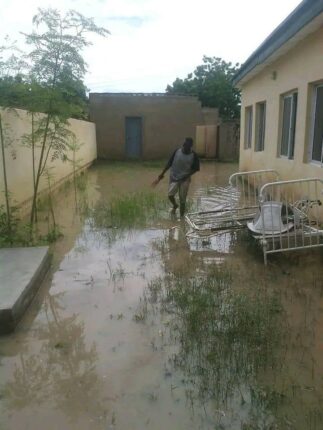
Photo Caption: worker at Walawa PHC holding a broomstick to sweep away the waters after the flood
Bashir Mamuda, the Officer-In-Charge of the clinic, explained that the facility has been deteriorating for more than two years. “We reached out to various authorities, including the state government, local government, SPHCDA, and partners, but no significant help has materialised,” said Mamuda.
“The clinic has managed to stay operational through funding from the Basic Healthcare Provision Fund (BHCPF) and Jigawa State Contributory Health Care Management Agency (JICHMA). We have even tried raising the entrance of the facility, but water still finds its way in,” he said.
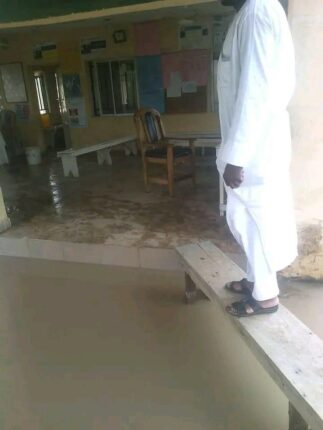
Photo Caption: Official standing on a bench to cross the flooded entrance at Walawa PHC
politics might be obstructing the necessary attention to address the flood issues at the PHC. He expressed frustration with the local government chairman’s inaction and pointed out that the drainage work, despite claims, was insufficient to prevent flooding.
Both Mamuda and Mohammad stressed the urgency of elevating the health facility by approximately 3 metres from its foundation to forestall future floods. While the clinic relies on BHCPF and JICHMA for support, they underscored the need for more substantial intervention to tackle the ongoing problem.
Similar to Walawa, Kudai Primary Health Center (PHC) heavily relies on the Basic Healthcare Provision Fund (BHCPF) to address the flood predicament that overwhelmed the healthcare facility in August 2022.
Musbahu Adamu, the Officer in Charge (OIC), pointed out that the PHC, catering to more than 17,000 residents, was rendered inoperative due to the deluge.
He elaborated, “The drainage system here is quite limited, unable to contain the vast amount of water that flowed in from across the road during the heavy rainfall. As a result, health workers and community members couldn’t access the clinic, which was entirely submerged by floodwaters. As a result, getting patients to the hospital became a challenging ordeal.”
Another health facility in Takazza, Guri LGA faced a similar plight. Amid the chaos, Mallam Bako, along with his family, were compelled to seek refuge in a nearby school, hastily transformed into a temporary healthcare center. Overwhelmed with patients, the overcrowded school struggled to accommodate the influx.
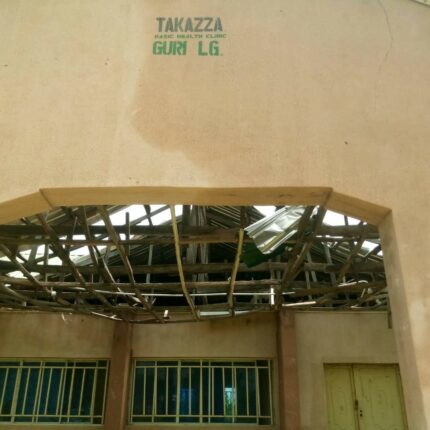
Photo Caption: The Guri LGA’s PHC at Takazza healthcare facility had suffered severe flooding damage and was no longer functional.
“All medical equipment that you know of a PHC should have all got damaged, nothing to see in the PHC,’’ Bako said.
He also called on the government to come to their aid and repair the hospital.
Despite the Jigawa State Governor, Umar Namadi’s, assurances that all necessary steps were being taken to alleviate the annual flooding and its repercussions in certain areas, recent investigations by this newspaper have brought to light a stark reality. Primary healthcare centres (PHCs) in flood-ravaged communities within the state remain in deplorable conditions, with the state government yet to effectively utilise available resources for the resuscitation and rehabilitation of these crucial facilities.
Officials react to efforts restoring PHCs impacted by floods
In an interview with SOLACEBASE, Surajo Suleiman, the PHC Manager of the Primary Health Care Development Agency (PHCDA) in Ringim, reported that approximately five PHCs in Ringim LGA were impacted by the flood. He mentioned that these affected PHCs have already submitted requests to the Local Government Chairman, although these requests have not yet been incorporated into the budget.
He clarified that while flooding has been a sporadic issue, the flood in August 2022 was particularly severe. Suleiman highlighted that renovations have been carried out at two of the affected PHCs, Kaura Dabi and Dingare. However, he expressed concerns that repairing Zangon Kanya and Walawa PHCs would be futile, as the problem would likely re-occur due to their location in flood-prone areas.
“Relocating these PHCs poses significant challenges since it is unlikely that individuals will willingly provide land for their reconstruction.”
‘’The Ringim Local Government Chairman, Alhaji Shehu Sule Udi, mentioned that he was not previously informed about the flooding impact at Zango Kanya PHC. He stated that the situation was only brought to his attention by an employee who informed him about the flooding issue at the clinic ‘’. However, he clarified that he has commenced drainage work at Walawa PHC.
Furthermore, he revealed that a delegation from the local government has been dispatched to evaluate the situation and intends to incorporate the issue into the 2024 budget.
The Dutse LGA PHC Director, Abdulhamid Ahmed, revealed to this reporter that the local government oversees more than 40 PHCs, and out of those, over three PHCs have been damaged by the floodwaters and are in urgent need of repairs. He said Kudai and Karnaya PHCs are notable for being severely flooded each year.
He explained that he had instructed all officers in charge of the affected PHCs to submit their complaints to the Local Government Chairman and the State Primary Healthcare Development Agency. Although they complied with this directive, they are still awaiting a response.
Read Also:JUST IN: Nigeria wins P&ID case in London
Efforts to speak with Jigawa State Commissioner of Health, Dr. Muhammad Kainuwa, and to
obtain information on the extent of government efforts to ameliorate the sufferings of those affected by flooding in the state through a Freedom of Information (FOI) request proved abortive.
The request dated September 6, 2023, specifically asked for the state government’s mitigation and preparedness measures, ensuring that affected communities do not undergo a recurrence of similar experiences in the event of future flooding.
Experts Outline Urgent Measures for Jigawa’s Flooding Crisis and Sustainable Healthcare Solutions
Dr. Emmanuel Balogun, Department of Biochemistry, Ahmadu Bello University, Zaria, Kaduna State, highlighted the predominant influence of Tiga and Challawa dams in Jigawa State. During the rainy season, the Hadejia River often breaches its banks, predisposing various regions to flooding.
He emphasized the dire consequences of the neglected PHCs, citing heightened risks of infectious diseases such as malaria, dengue, yellow fever, and schistosomiasis, which can be transmitted by vectors like mosquitoes and snails carried by floodwaters. Additionally, he stressed the increased vulnerability to snake bites, as floodwaters facilitate the movement of snakes into direct contact with people.
To avert future flooding and its detrimental impact on PHCs, Dr. Balogun proposed that the government should construct well-equipped primary healthcare facilities on elevated, flood-inaccessible terrain.
Mr. Jubril Shittu, a development expert and CEO of the Public and Private Development Centre in Abuja, highlighted that flooding in Nigeria is a recurrent issue influenced by various factors, including climate change and overflowing water bodies.
He remarked, “Without conceding the specifics of the Jigawa State terrain, one can recognize the evident impact of climate change on the environment. More rainfall is being observed in certain regions compared to previous years, amplifying the effects even in areas facing similar flooding challenges.”
Read Also:Girls’ Education: PAGED Initiative partners SOLACEBASE
He stressed that the state government must refrain from relying on outdated solutions for modern challenges. “We need innovative approaches to tackle the 21st-century issues, namely climate change and global warming,” he emphasized. Shittu underscored the imperative of introducing diverse responsibilities and qualities to be implemented from both federal and state government perspectives.
He emphasized that as the management and dredging of waterways fall under the purview of the Federal Government through the National Inland Waterways Authority, it is crucial to ensure that the waterways remain free from sand accumulation, which can contribute to the elevation of water beds.
Furthermore, he highlighted that while the construction of dams currently remains under federal government control, the present administration is contemplating devolving this responsibility to the state once it shifts to the concurrent list. In this case, the state would be tasked with providing electricity, particularly if it has an independent power project, as well as potential irrigation and flood protection measures.
He pointed out that the designation and allocation of lands on floodplains by the state government through its Ministry of Lands should be done right and not backed by greed. He noted that most floodplain areas are mostly given out to people by the state while the unsuspecting public builds on the lands without carrying out due diligence.
He emphasised the importance of conducting proper due diligence before constructing on floodplains, highlighting that without consulting Geographic Information System Specialists or the Development Authority for mapping, individuals often proceed with building. This lack of due diligence, combined with the impact of climate change, inevitably leads to persistent flooding of the floodplain.
Moreover, he underscored that Nigerian infrastructural development has fallen behind in addressing the challenges posed by flooding and the expectations of effective flood management.
He pointed out that the majority of two-lane public roads lack sufficient and standardized gutters or drainage systems to effectively manage floodwaters during heavy rainfall. He attributed this inadequacy to the faulty procurement and monitoring of infrastructure projects, emphasizing the critical need for the proper maintenance of gutters and drainages.
He further highlighted the government’s failure to adapt to the new environmental realities, resulting in the absence of comprehensive planning for flood mitigation measures. He lamented that many of the solutions being implemented are not sustainable in the long run.
Read Also:College principal, vice in police custody for allegedly flogging student to death in Kaduna
He also emphasized the importance of heightened public awareness through extensive sensitization efforts, emphasizing that the National Orientation Agency has limited capabilities in this context.
He stressed the value of community engagement, advocating for town hall meetings and comprehensive post-flood assessments to evaluate what worked well and what did not. He suggested the collection of data on affected individuals, their coping mechanisms, and the implementation of these measures at the community level, commissioned by the state government.
Regarding the local government’s role, he underscored the significance of sanitation activities, conducting assessments of flood-prone regions, initiating sensitization campaigns, and ensuring the cleanliness of gutters, drainage systems, and communal storage facilities. He emphasized that the local government is closer to the communities and urged the state to embrace proactive planning and implementation without relying solely on the federal government for support.
This SOLACEBASE publication is produced with support from the Wole Soyinka Centre for Investigative Journalism (WSCIJ) under the collaborative Media Engagement for Development, Inclusion, and Accountability Project (CMEDIA) funded by the MacArthur Foundation.

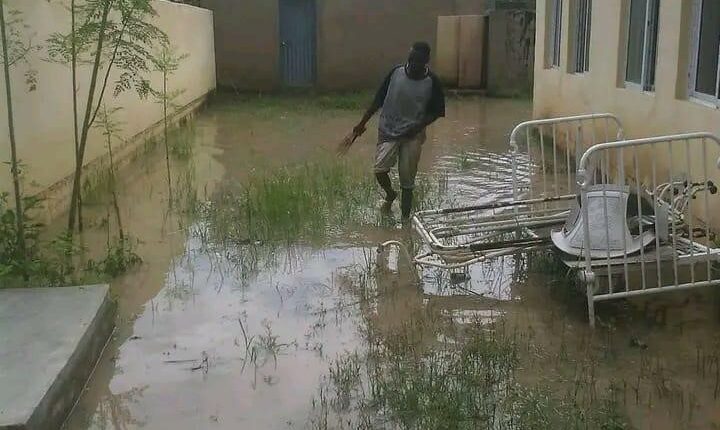

Comments are closed.